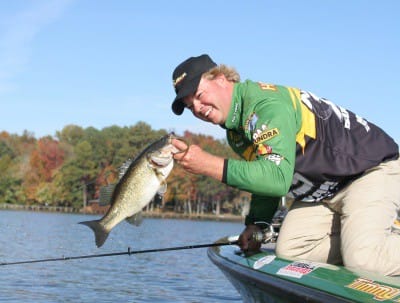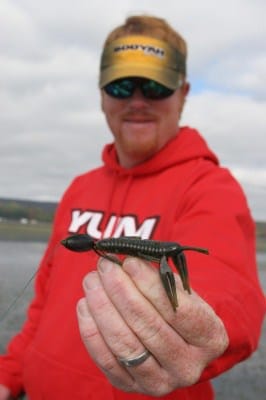
Body language can speak volumes. Whether a co-worker, maybe a spouse or even a stranger across the room, you can tell a person’s mood simply by the way they hold their arms or perhaps tilt their head. Visible bass also display subtle actions that reveal their moods. A fish can be a bit tougher to read, but some anglers, like Florida tournament angler Tim Mann, can look at a bass cruising a shallow flat or hovering over a bed and read it like a book. How it reacts to a boat or a lure can offer clues that can help you catch that fish.
Some visible bass are simply uncatchable. They offer the most obvious body language: complete, utter rejection. A bass that abandons its bed and races for deeper water? Forget it, says Mann. Any bass that leaves a silt trail in its wake is gone for good, or at least gone long enough that it’s simply not worth any effort to catch it. Mann says the faster a bass scoots away from a boat or a lure, the less likely it’s going to eat that lure.
If, however, that fish simply moves away slowly and then stops, there’s a good chance it can be caught. It might be guarding a nearby bed or it may simply be cruising a shallow flat, searching for food or a suitable place to fan out a bed. Both are common sights in the spring. What ever that fish is doing, it’s vital to study it before making the first cast. Mann will wait 30 minutes or more if he feels like he needs to.
“The fish knows you are there, but the longer you wait, the more comfortable it will be with your presence. Watching it also gives you an idea of its mood,” he says.
He doesn’t get too close, though. Smallmouths are much more tolerant of a boat floating above them. Largemouths, however, need a little space. That’s why Mann will stay far enough away that he can watch the fish but still make an accurate cast.
The most obvious, and the most important thing he hopes to see, is a bass that turns to face the boat. It’s a defensive posture that Mann compares to a couple of men squaring off in a bar. Just as those men puff their chests, bass also attempt to look bigger.
“I look for that fish to open its gills a bit and extend its fins,” he explains. “It’s trying to make itself look bigger because it feels threatened. If those fins are going back and forth real quick, that’s a sign it’s agitated. And that’s a good sign. That’s what I’m looking for.”
When he sees that, he’ll either drop a lure near the fish or directly into its bed. If the fish moves forward or at least stands its ground, Mann is even more confident he’s going to hook it. Even better, if the bass tips up or rolls toward the bait, it’s only a matter of time, even if it doesn’t inhale the bait right away. If, however, the fish retreats when the lure hits the surface, Mann will let the bait sit on the bottom for several minutes without even twitching it. When the fish returns, Mann simply shakes his rod tip just enough to make the bait come alive.
“I don’t hop it. I want it to stay in one place, especially if the bait is in a bed. That’s going to aggravate the fish even more,” says Mann.

His favorite bait is a 4-inch Yum shad-colored tube. It not only mimics a baitfish, it’s light enough that he can see it as it rests on the bottom. If that bait doesn’t draw a strike, he’ll switch to a Yum Craw Papi, his other go-to sight-fishing lure. What you use is somewhat less important than how you use it. What matters most, says Mann, is patience.
“Too many anglers work a fish for a few minutes and then give up,” he says. “I spent an hour-and-a-half on a bass recently before I caught it. It ended up weighing 9 pounds.”
The Union Sportsmen’s Alliance website is designed to provide valuable articles about hunting, fishing and conservation for members of AFL-CIO affiliated labor unions and all sportsmen and sportswomen who appreciate hunting and fishing and want to preserve our outdoor heritage for future generations. If you would like your own story and experience from the outdoors to be considered for our website, please email us at USAmembers@unionsportsmen.org.



